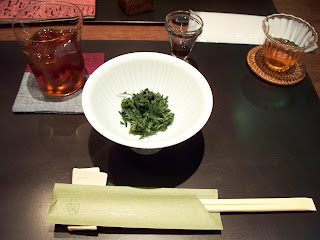
Whenever I'm in Osaka, Uji-ko en is a must visit, the tiring weaving between seas of shoppers in Namba makes this little teahouse even more inviting. The only Japanese tea I really enjoy drinking is probably gyukuro, and the teamaster at Uji-ko en makes the best I've tried in many places. The delicately brewed gyukuro is creamy, with a slight bitterness that reaches deep down the throat and returns refreshingly sweet. I can never brew a gyukuro this good...

This time though, I was treated to a surprise. The teamaster told me that she would brew the gyukuro four times, then - she gestured rather than told me plainly, since I cannot speak Japanese and she speaks no English - she would prepare the leaves for me to eat.
What appeared before me at the end of the fourth brew was a small dish of blanched gyukuro leaves in ice water, and a small flute of soya sauce. I was to dab a little of the sauce on the leaves for flavor.
I had expected the leaves to be slightly bitter but surprisingly, it tasted deliciously sweet with a hint of kelp, and none of the grassiness one expects from a Japanese green tea.
Beautiful.


5 comments:
Danny,
that sounds like an interesting experience.
Eating tea leaves is not too uncommon. The Burmese, for example, have a delicious specialty, a tea leaf salad, where slightly pickled tea leaves are used.
Danny,
I am delighted by your report of experiencing tea as a food.
Well before tea was a beverage, it was a vegetable and herb used in cooking from at least the Zhou and Han dynasties for its bitter taste. Bitterness was the first of the five traditional flavors in Chinese cuisine.
As a vegetable, tea was a complement to meat, fowl, and eggs. As an herb, it was added to soups and stews of fish, pork, beef, and chicken. These uses are documented in historical and archaeological sources.
I have eaten Dragon Well tea and freshwater shrimp in the famous Hangzhou dish, but will have to try gyokuro and soyu sometime soon. Thanks for the tip.
Steve.
Thanks Steve, & Jo
:")
I remembered the Burmese pickled tea leaves! My dad went on a business trip to Burma once and brought home a packet of the pickled leaves, only they were more heavily pickled. I thought it was another type of tea called the pounded tea (lei cha), and happily set about adding peanuts, sesame seeds, chopped parsley and added hot water to the mixture. It didn't taste good at all! Of course I was told that it was a wrong dish later...
Yunnanese also have a similar practice where they would layer fresh tea leaves in an urn with salt and then press down with a rock, this they leave it alone for weeks till the thing ferments slightly, then they take it out to eat with their meals. One good dish to eat it with - as I watched it on Discovery channel - was to disturb a hornet nest, drag out all the worms and then chop and mash them into a bloody pulp. Scoop a bit of this and add a bit of the leaves and the locals have this euphoric expression on their faces...urgh!
My only tea eating experiences have been when a tea leaf slips into my mouth while drinking! Not pleasant. But the way you described it here, gyokuro sounds quite nice. Interesting touch to have it with the soy sauce. That doesn't seem like the most natural combination to me; did it work well?
Hi Eric,
The Japanese soy sauce was very light, and given the amount, I don't think it was meant to be poured over the leaves, but rather, just a hint to lift the taste.
The leaves tasted sweet without the soy sauce, but when I dipped the chopsticks in the sauce and then picking the leaves and tasting them, they tasted much sweeter...
:")
Post a Comment